Quilt Solution
How it works
Teams shake down the salesman and acquire a quilt; one with their team name embroidered on the tag.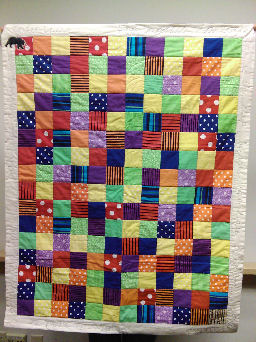
The text around the quilt reads:
- "find ingress via each box if the step bridges immediate neighbors along rainbow"
- "yellow is next to orange and lime"
- "path helps ambling bear enter trees"
The first step is to solve the maze according to these directions:
- Start at bear, end at trees.
- Step only to immediately adjacent squares.
- Only step if the colors of the adjacent squares are also adjacent on the rainbow. Purple is considered to be adjacent to red.
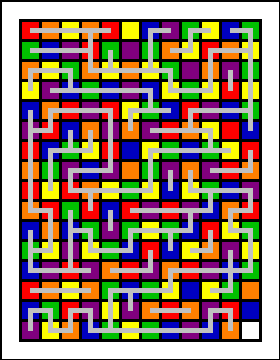
The path itself doesn't help much; it does not resolve into words or a clear picture. Noticing that the phasing of the instructions is odd, teams find a hidden message by reading the first letter of each word: FIVE BITS BINARY INTO ALPHABET.
Binary is obtained by looking at the transitions between path squares; if the next color is "up" the rainbow record a 1, if it is "down" the rainbow record a 0.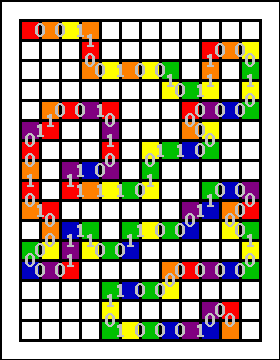
Using 1=A and 0=space, the phrase is decoded: FIND MORSE OFF PATH.
Ignoring the path squares, treat polka-dot as dot, stripes as dash, and solid colors as letter breaks. The final message can be read: UNDER RED DOT BETWEEN TWO YELLOWS.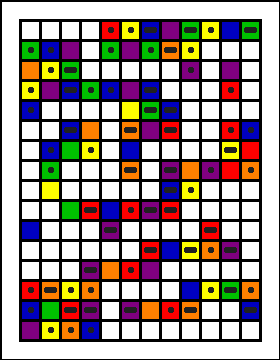
There is only one red polka-dot square directly between two yellow squares, in the upper right quadrant. With a sharp knife or a bright light, the hidden contents of this square are revealed: a scrap of fabric with a picture of a hacksaw!
Solution
HACKSAW
Design notes
The "trees" square was originally green forest, but playtesters were confused by the transition from orange, so I had to search far and wide for a neutral tree print.
When planning supply purchases, I forgot there was a separate Beta and RC for the event, so I didn't have enough quilts. The solution was to sacrifice one quilt, cutting each square into quarters to make four mini-quilts. There were a few problems with scale: the red polka-dot fabric had to be cut carefully to make sure there was a visible dot, the bears had to have their rear legs removed, and the answer had to be sharpie because the hacksaws were too large to fit inside the mini squares.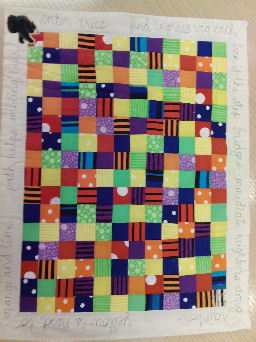
The number of squares of each fabric and the direction of the striped squares were carefully balanced to prevent extra signal. Playtests also found that trying to extract Morse code or binary in any way other than the intended way quickly led to nonsense, with only one or two minor changes. These measures seem to have prevented people from running down the wrong path for too long.
Make your own
I have understandably had requests for additional copies of this puzzle. The materials are not too expensive, but creating the quilts is an extremely labor intensive task. (Thanks again to Karen who donated many hours of sewing because I somehow thought it might be a fun activity we could do together.)
I will not be making any more of these. Ask Karen at your own risk. 😉
On the other hand, I will be happy to provide plans and advice. If you show me that you have completed your quilt I will even create a custom label for you to sew onto the back. Quilt shops will help you get started, and even the other customers will lend advice. Learning to quilt can be a fun and rewarding experience, and can help you connect with your mother/grandmother/sister or other family mentor. Or you can just bribe them to do it for you.
Unless you are an experienced quilter, you can expect to spend at least 40 hours on this project. I purchased cheap materials in bulk and on sale for an average cost of about $20 per quilt. You should expect to pay $50-$100 for materials, especially if you want to use good quality fabrics and thread, and a proper border and backing material.
The quilts I made used a thin, inexpensive muslin as backing material, which was wrapped around the edges after quilting to create the border. If you do one thing to improve your quilt, create a traditional border. Use some soft, cuddly material for the backing.
The pattern is relatively straightforward: 3" blocks + .5" for seam allowance. Sew the blocks into strips (either horizontal or vertical, it really doesn't matter) and then sew the strips into a grid. Add a border, quilt it to a back, and bind it. Be sure to verify everything 3 times as you go. The bear can be cut from an appropriate print and fused to the quilt-top. Zig-zag stitch around the bear to hold the edges down. Quilt using "invisible" thread on the top and something to match your backing fabric on the back. Stitch-in-the-ditch (a walking foot is helpful here) to avoid adding signal to the puzzle. Write the instructions on the border using a disappearing fabric pen and trace them using a contrasting thread with the feed-dogs lowered and a freehand quilting foot on your sewing machine.
Materials List:
Specialty prints: bear (1), trees (3,5" square), hacksaw (1)
Border: 2.5" x 40.5" (2), 2.5" x 48.5" (2) (for non-mitered corners)
Backing and Batting: minimum 41" x 53" (an extra 4" in each direction will make your life easier)
Top: 3.5" squares:
**** stripe --- --- Red 10 Orange 10 Yellow 11 Green 11 Blue 11 Purple 10 Thread: invisible, back color, neutral for bear, contrasting for instructions
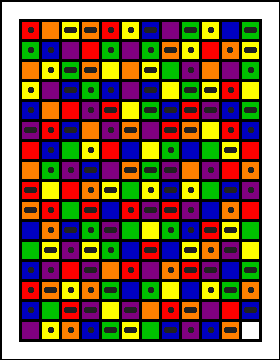
*See picture of finished quilt for direction of stripes, which is not important to the solution of the puzzle, but were carefully balanced to avoid the appearance of relevance.
GC notes
Several teams were distraught when they realized the answer was inside the quilt. Those who asked on-site staff got the suggestion that bright light might allow them to see the hidden answer without destroying the quilt.